Bayex and Caen
September 26 - After an overnight journey to complete our voyage from Amsterdam we arrived in the canal leading to Caen in the morning. Prior to beginning our day we were treated to a program about the Bayeux Tapestry by one of our historians. I had brought along the reproduction of a portion of the Bayeux that I had done several years ago, so I was invited to contribute to the lecture on this history and techniques used in producing this masterpiece. Then I stayed around so that those who wished could actually look at the stitching technique close up and ask me about it.
Immediately after lunch we boarded buses to travel the short distance to the town of Bayeux, a lovely old town in Normandy that maintains much of its old-fashioned charm. Though the centuries have moved the center of political power far from Bayeux, anyone who is fascinated by great events that shook the world should be familiar with this place.
Founded as a Gallo-Roman settlement in the 1st century BC under the name Augustodurum, Bayeux is the capital of the former territory of the Bodiocassi people of Gaul, whose name appears in the writings of Pliny the Elder. The city was largely destroyed during the Viking raids of the late 9th century but was rebuilt in the early 10th century under the reign of Bothon. The 11th century saw the creation of five villages beyond the walls to the north east evidence of its growth during Ducal Normandy.
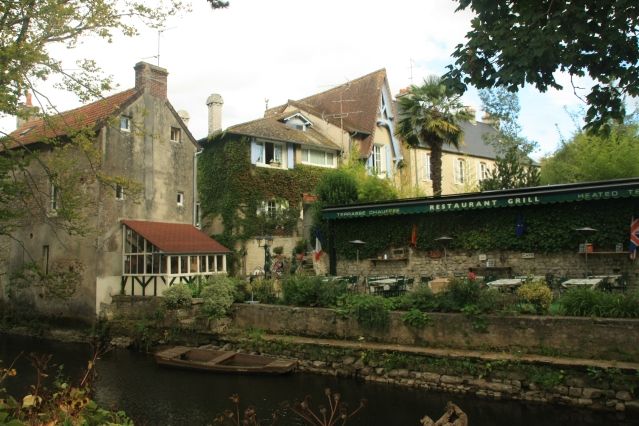
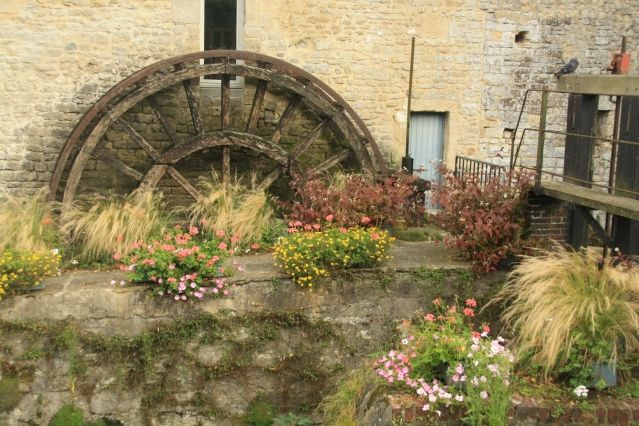


In the center of the town is the massive cathedral at Bayeux (Cathédrale Notre-Dame de Bayeux) which was dedicated in 1077 when Bishop Odo, half-brother to William the Conqueror, was Bishop here. In fact William was present at the time of the dedication as he was both Duke of Normandy and King of England by that time. But parts of the building are older than that, and it was here that Harold Godwinson is supposed to have taken an oath upon holy relics to support William's claim to the throne of England. Harold's later assumption of the crown was the act that launched the Norman invasion of Britain in 1066 that laid the foundation for modern England. Older yet are the crypts beneath the building which contain pillars of the Roman temple that occupied this site before the advent of Christianity.


The inside of the Cathedral is a lovely example of the Norman style of architecture with the huge barrel vault of the ceiling.

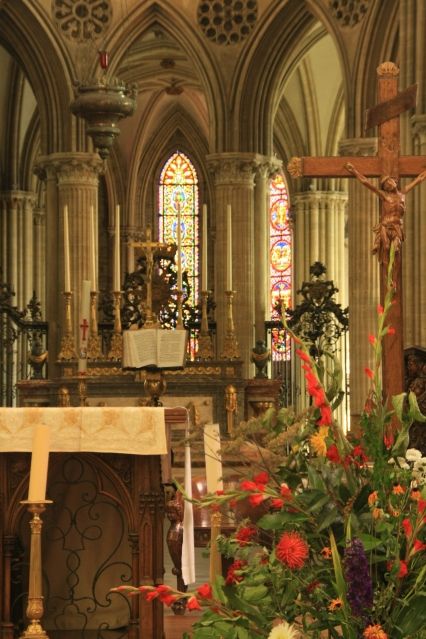
Many of the stained-glass windows in the Cathedral are the original medieval ones and I was fascinated by the play of light and color they created in the dimness of the chapels.

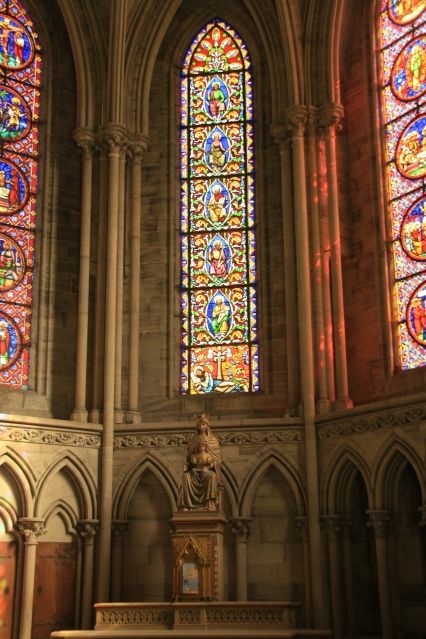


Because of its location in Normandy, the area around Bayeux was the site of heavy fighting during the D-Day invasion. Fortunately the town itself was spared. But the people of Bayeux still remember their liberators. There is a large British WWII cemetery just outside of the town, and every year on June 6 special services are held at the Cathedral. We stopped to light a candle for world peace at the Peace Chapel in the Cathedral.

Of course the main reason for the visit to Bayeux and the one which I had anticipated for so long was a visit to the museum to see the Bayeux Tapestry. The Tapestry, which commemorates the Norman invasion in 1066 AD is actually not a tapestry at all, but rather a 220-foot long piece of linen embroidered with wool. It was almost certain commissioned by Bishop Odo and created in England sometime between 1066 and Odo's death in 1097. For something which is nearly 1000 years old the colors are amazing and the story as compelling as it was when it was created. Unfortunately of course they do not permit photography of the Tapestry, and even if they had it would have been difficult to get good shots through the protective glass. Suffice it to say, the bit that I did a reproduction of looks exactly like the original. I took my piece with me to meet its more famous cousin and the docent was very impressed with my work. (This picture is of my work...not the original...but you get the idea.
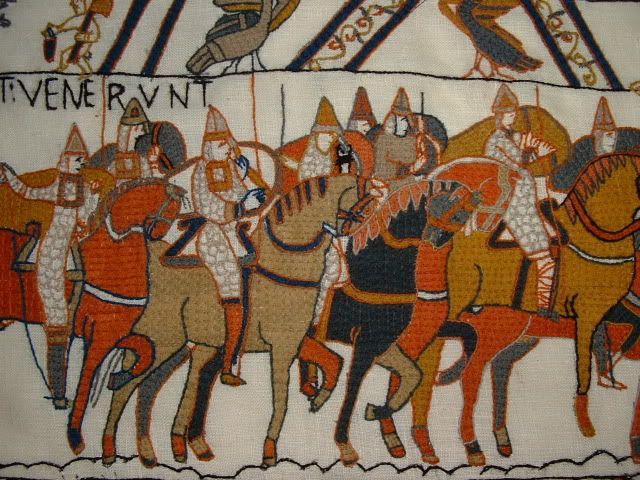
After leaving Bayeux we drove back to Caen and had a very brief bus tour of that city. Because Caen was a major port city held by the Germans and needed by the Allies there was heavy fighting and bombing here during WWII and much of the old city of Caen was destroyed. But we did pass two important medieval structures.
Eglise Stienne, formerly the Abbaye aux Hommes (Men's Abbey) was completed in 1063 and is dedicated to St. Stephen. The current Hôtel de Ville (town hall) of Caen is built onto the South Transept of the building.
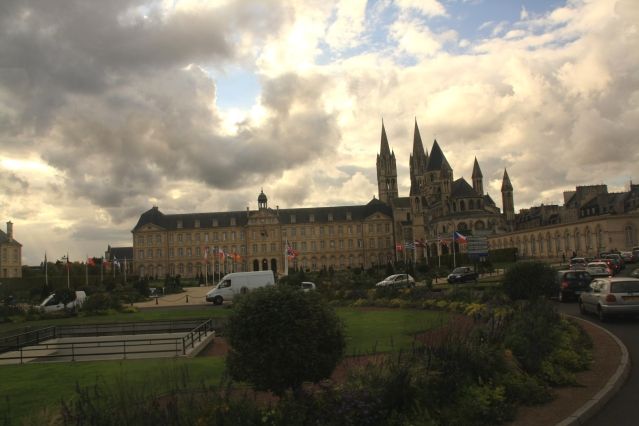
Eglise-de-la Ste - Trinite', formerly the Abbaye aux Dames (Women's Abbey). It was completed in 1060 and is dedicated to the Holy Trinity.
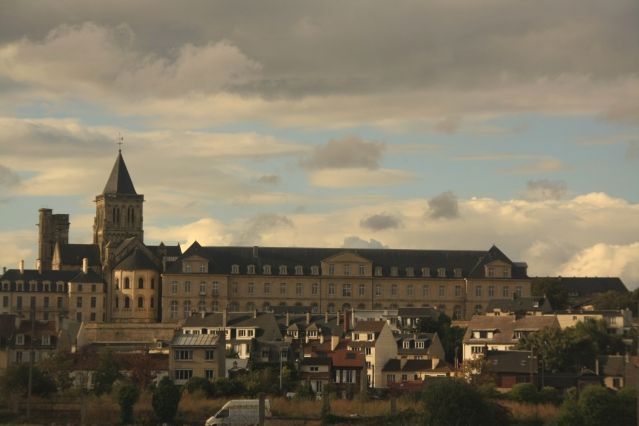
The two structures were built by order of William the Conqueror and his queen, Mathilda as a penance suggested by the Pope for the two cousins marriage without the approval of the Church.
Sadly we were not able to visit the Castle of Bayeux which was built by William the Conqueror when he made Caen his capital in Normandy.
On our way out of town we spied Jacques Cousteau's ship, the Calypso, tied up along one of the canals.

We returned to the ship just as dusk was falling over Caen.

The ship was to remain at anchor at Caen overnight and tomorrow we would spend the entire day touring the D-Day sites. So after a cocktail and snacks and then a tasty dinner we were off to bed.
Immediately after lunch we boarded buses to travel the short distance to the town of Bayeux, a lovely old town in Normandy that maintains much of its old-fashioned charm. Though the centuries have moved the center of political power far from Bayeux, anyone who is fascinated by great events that shook the world should be familiar with this place.
Founded as a Gallo-Roman settlement in the 1st century BC under the name Augustodurum, Bayeux is the capital of the former territory of the Bodiocassi people of Gaul, whose name appears in the writings of Pliny the Elder. The city was largely destroyed during the Viking raids of the late 9th century but was rebuilt in the early 10th century under the reign of Bothon. The 11th century saw the creation of five villages beyond the walls to the north east evidence of its growth during Ducal Normandy.




In the center of the town is the massive cathedral at Bayeux (Cathédrale Notre-Dame de Bayeux) which was dedicated in 1077 when Bishop Odo, half-brother to William the Conqueror, was Bishop here. In fact William was present at the time of the dedication as he was both Duke of Normandy and King of England by that time. But parts of the building are older than that, and it was here that Harold Godwinson is supposed to have taken an oath upon holy relics to support William's claim to the throne of England. Harold's later assumption of the crown was the act that launched the Norman invasion of Britain in 1066 that laid the foundation for modern England. Older yet are the crypts beneath the building which contain pillars of the Roman temple that occupied this site before the advent of Christianity.


The inside of the Cathedral is a lovely example of the Norman style of architecture with the huge barrel vault of the ceiling.


Many of the stained-glass windows in the Cathedral are the original medieval ones and I was fascinated by the play of light and color they created in the dimness of the chapels.




Because of its location in Normandy, the area around Bayeux was the site of heavy fighting during the D-Day invasion. Fortunately the town itself was spared. But the people of Bayeux still remember their liberators. There is a large British WWII cemetery just outside of the town, and every year on June 6 special services are held at the Cathedral. We stopped to light a candle for world peace at the Peace Chapel in the Cathedral.

Of course the main reason for the visit to Bayeux and the one which I had anticipated for so long was a visit to the museum to see the Bayeux Tapestry. The Tapestry, which commemorates the Norman invasion in 1066 AD is actually not a tapestry at all, but rather a 220-foot long piece of linen embroidered with wool. It was almost certain commissioned by Bishop Odo and created in England sometime between 1066 and Odo's death in 1097. For something which is nearly 1000 years old the colors are amazing and the story as compelling as it was when it was created. Unfortunately of course they do not permit photography of the Tapestry, and even if they had it would have been difficult to get good shots through the protective glass. Suffice it to say, the bit that I did a reproduction of looks exactly like the original. I took my piece with me to meet its more famous cousin and the docent was very impressed with my work. (This picture is of my work...not the original...but you get the idea.

After leaving Bayeux we drove back to Caen and had a very brief bus tour of that city. Because Caen was a major port city held by the Germans and needed by the Allies there was heavy fighting and bombing here during WWII and much of the old city of Caen was destroyed. But we did pass two important medieval structures.
Eglise Stienne, formerly the Abbaye aux Hommes (Men's Abbey) was completed in 1063 and is dedicated to St. Stephen. The current Hôtel de Ville (town hall) of Caen is built onto the South Transept of the building.

Eglise-de-la Ste - Trinite', formerly the Abbaye aux Dames (Women's Abbey). It was completed in 1060 and is dedicated to the Holy Trinity.

The two structures were built by order of William the Conqueror and his queen, Mathilda as a penance suggested by the Pope for the two cousins marriage without the approval of the Church.
Sadly we were not able to visit the Castle of Bayeux which was built by William the Conqueror when he made Caen his capital in Normandy.
On our way out of town we spied Jacques Cousteau's ship, the Calypso, tied up along one of the canals.

We returned to the ship just as dusk was falling over Caen.

The ship was to remain at anchor at Caen overnight and tomorrow we would spend the entire day touring the D-Day sites. So after a cocktail and snacks and then a tasty dinner we were off to bed.